Physical Address
304 North Cardinal St.
Dorchester Center, MA 02124
The classification of appendiceal epithelial tumors is shown in Box 28.1 . The classification, nomenclature, and histological criteria of mucinous epithelial tumors in the appendix have been the source of considerable controversy. In particular, mucinous epithelial tumors that penetrate deeply into or through the appendiceal wall and disseminate to the peritoneal cavity, resulting in pseudomyxoma peritonei, were the source of much of this controversy. For example, the exact nature of their biological potential (benign vs. malignant, invasive vs. noninvasive) has been a matter of intense debate and has led to nosological confusion. Historically, they were classified as either ruptured adenomas with dissemination of adenomatous epithelium or as adenocarcinomas . In 2003, the term low-grade appendiceal mucinous neoplasm (LAMN) was introduced for a subset of these tumors, and this term is now universally adopted for tumors that show “pushing” or “broad-front” invasion combined with low-grade cytological features. In contrast, tumors with pushing invasion and high-grade cytological features are termed high-grade appendiceal mucinous neoplasm (HAMN). In contemporary classification systems, a diagnosis of adenocarcinoma in the appendix still requires invasion of an infiltrative, not pushing, nature. ,
The nomenclature of goblet cell tumors has also undergone significant recent revision. This enigmatic tumor shows both endocrine and mucinous differentiation and thus has been difficult to classify historically. The classification of these tumors is particularly complicated when they demonstrate high-grade cytological features. For instance, some proposed names for this tumor have included goblet cell carcinoid, crypt cell carcinoma, mixed adenocarcinoma carcinoid, and adenocarcinoma ex goblet cell carcinoid. Recently, these tumors were reclassified as goblet cell adenocarcinoma because they typically show glandular or mucinous differentiation, they are staged similarly to adenocarcinomas, and chemotherapy regimens similar to those used for colorectal adenocarcinoma are used in patients with disseminated tumors.
Historically, the finding of a dilated appendix lined by clearly neoplastic epithelium was often referred to as a mucinous cystadenoma, but this term engendered controversy over whether this same tumor, when it spreads to the peritoneum or ovaries, should be termed a ruptured cystadenoma or a cystadenocarcinoma . However, since the introduction of the term LAMN for tumors with similar histological features, the term mucinous cystadenoma has been discontinued. LAMN is now the accepted term for low-grade epithelial neoplasms that demonstrate pushing invasion and also show spread to the peritoneal cavity.
Whether any tumors should still be classified as appendiceal adenoma is unclear and controversial. Some authorities believe that mucinous neoplasms that are confined to the mucosa of the appendix and also show preserved muscularis mucosae should still be recognized as an adenoma because of their uniform benign outcome once excised. However, other authorities believe that all mucinous neoplasms should be termed LAMN, even if they are restricted to the appendiceal mucosa and without pushing invasion. The Peritoneal Surface Oncology Group International consensus document maintains the designation of adenoma only for lesions that resemble their colorectal counterparts; namely, dysplastic lesions that are tubular, tubulovillous, or villous and show features of intestinal-type dysplasia with elongate, hyperchromatic, and pseudostratified nuclei. However, the World Health Organization (WHO) no longer specifically includes the term adenoma in its classification of appendiceal tumors. Nevertheless, in this chapter, the term adenoma is reserved for dysplastic appendiceal epithelial proliferations that have intestinal-type epithelium, lack hypermucinous features characteristic of LAMN, are tubular, tubulovillous, or villous (and not a flat single layer), and do not show mucin in the wall of the appendix.
Localized tubular adenomas of the type that occur in the colon are, in fact, rare in the appendix. , However, they may occur in patients with familial adenomatous polyposis. , Most are incidentally found in appendices removed for other clinical reasons. Large villous adenomas may present with abdominal pain. Tumors in the base of the appendix may represent an extension of a cecal tumor into the appendix, so pathologists should always be aware of this differential diagnosis. The pathogenesis of appendiceal adenomas has never been studied because most of the literature on this topic predates the introduction of the term LAMN . They presumably have a similar pathogenesis to colorectal adenomas, but this remains to be tested.
Grossly, adenomas of the appendix may show a polypoid or semi-sessile polypoid appearance. By definition, the appendix is not dilated or filled with mucin, as is typical of LAMNs.
The histological appearance of tubular adenomas of the appendix is identical to those that occur in the colon. They may be low grade or high grade. Low-grade tumors show glands lined by cells with elongate, pseudostratified nuclei, with occasional mitotic figures and nuclear debris ( Fig. 28.1 ). High-grade tumors show more architectural complexity, and the glands often show cribriform architecture, micropapillary infoldings, or full thickness stratification. The glands are lined by cells showing high-grade nuclear features, including enlarged nuclei, prominent nucleoli, increased mitotic figures, increased nuclear-to-cytoplasmic (N/C) ratio, loss of polarity, and occasionally pleomorphism.
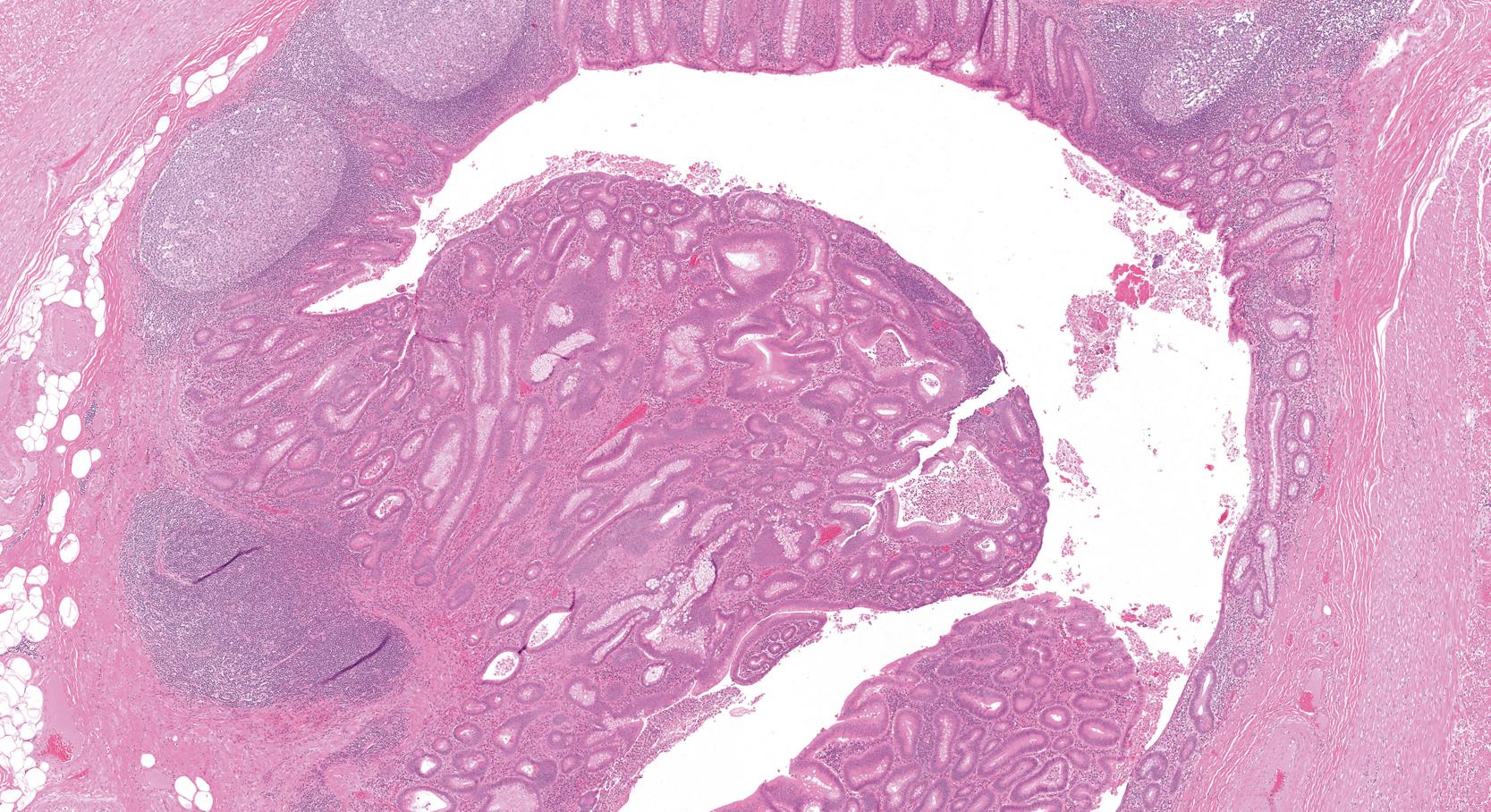
Villous adenomas resemble colorectal villous adenomas and are lined by intestinal-type epithelium with hyperchromatic, elongate, and pseudostratified nuclei similar to those that occur in the colon. They can also be low- or high-grade, similar to tubular adenomas.
The main differential diagnosis is with LAMNs. However, as mentioned earlier, the term appendiceal adenoma is reserved for lesions that resemble colorectal-type adenomas and without prominent mucin production. All cystically dilated tumors lined by a single layer of dysplastic epithelium are classified as LAMN . Similarly, villous tumors in which the villi are lined by hypermucinous epithelium are more appropriately classified as LAMN, even if they are confined to the mucosa.
Appendiceal adenomas are benign lesions. They are cured by appendectomy. However, if left untreated, they represent a precursor to invasive appendiceal adenocarcinoma. Appendectomy is sufficient treatment for benign appendiceal adenomas.
LAMNs are mucinous neoplasms with low-grade cytological features that are either confined to the mucosa or show pushing invasion into or through the appendix wall, and, when the appendix ruptures, they may spread to the peritoneal cavity as pseudomyxoma peritonei. Historically, most low-grade mucinous tumors of the appendix were classified as mucinous cystadenoma . However, when these tumors spread beyond the appendix, terms such as ruptured mucinous cystadenoma or mucinous adenocarcinoma have been used, which has created confusion. Because the criteria for tissue invasion in these tumors was believed to be poorly defined, other terms that were applied included mucinous tumor of uncertain malignant potential or borderline tumor . In 2003, the term LAMN was introduced for these tumors to circumnavigate the controversy over whether they are benign or malignant and to allow them to be classified regardless of whether they had spread to the peritoneum. This term has gained widespread acceptance and has enabled progress to be made on the clinical, pathological, and molecular aspects of these tumors. However, it should be recognized that in much of the prior literature, so-called appendiceal adenomas were in fact LAMNs.
LAMNs usually present in the sixth decade of life, although the age range at presentation is quite broad (18 to 89 years). , , , , There is a predilection for females. , , , Patients may present with abdominal pain, a palpable abdominal mass, or even with ovarian metastasis. , , , , In fact, ovarian metastasis may predate discovery of the primary appendiceal tumor. Other clinical presentations include intussusception of the appendix , or the finding of mucin within a hernia sac. A retrocecal LAMN can present as a retroperitoneal mass or as pseudomyxoma extraperitonei. Approximately 15% to 20% of LAMNs are discovered incidentally in patients who have undergone surgery for an unrelated condition. , , In some studies, there is an association between LAMNs and other types of colonic neoplasms and polyps.
LAMNs show frequent KRAS mutations. Also, about 50% of LAMNs have GNAS mutations. , Activating GNAS mutations cause constitutive activation of adenylate cyclase and elevated cAMP levels. In cell lines, this is associated with increased expression of MUC2 and MUC5AC, raising the intriguing possibility that GNAS mutations play a role in mucin production, which is a hallmark of LAMNs and its associated complication pseudomyxoma peritonei (see later). LAMNs have not been shown to demonstrate microsatellite instability or other features of the mutator pathway, such as loss of expression of DNA mismatch repair proteins or BRAF mutations. , , Other mutations occur but are rare, such as TP53, RB1, APC, MET, RNF43, and PIK3CA. ,
Nuclear expression of β-catenin has been observed in LAMNs, but CTNNB1 mutations are infrequent. Bibi et al. showed that N-cadherin expression is increased in appendiceal mucinous tumors and associated pseudomyxoma peritonei, whereas E-cadherin expression is reduced relative to normal epithelium. They also showed vimentin expression in these tumors. These authors suggested that a shift in cadherin phenotype and vimentin expression may reflect an epithelial-mesenchymal transition in which epithelial cells switch to a mesenchymal phenotype, a process that presumably promotes metastasis.
Appendices with LAMNs may appear grossly unremarkable, or they may be cystically dilated and filled with abundant tenacious mucin. , , , The wall may be thin or fibrotic, hyalinized, and calcified ( Fig. 28.2 ). , Rupture of the tumors with the presence of mucin on the serosal surface or within the peritoneal cavity may be grossly evident. , , , Infrequently, the appendix may be completely encased in mucin or even fused to the right ovary. , , The appendix lining may be smooth, granular, or corrugated with intervening smooth areas. Focal outpouchings of the lumen, filled with mucin, have also been described.
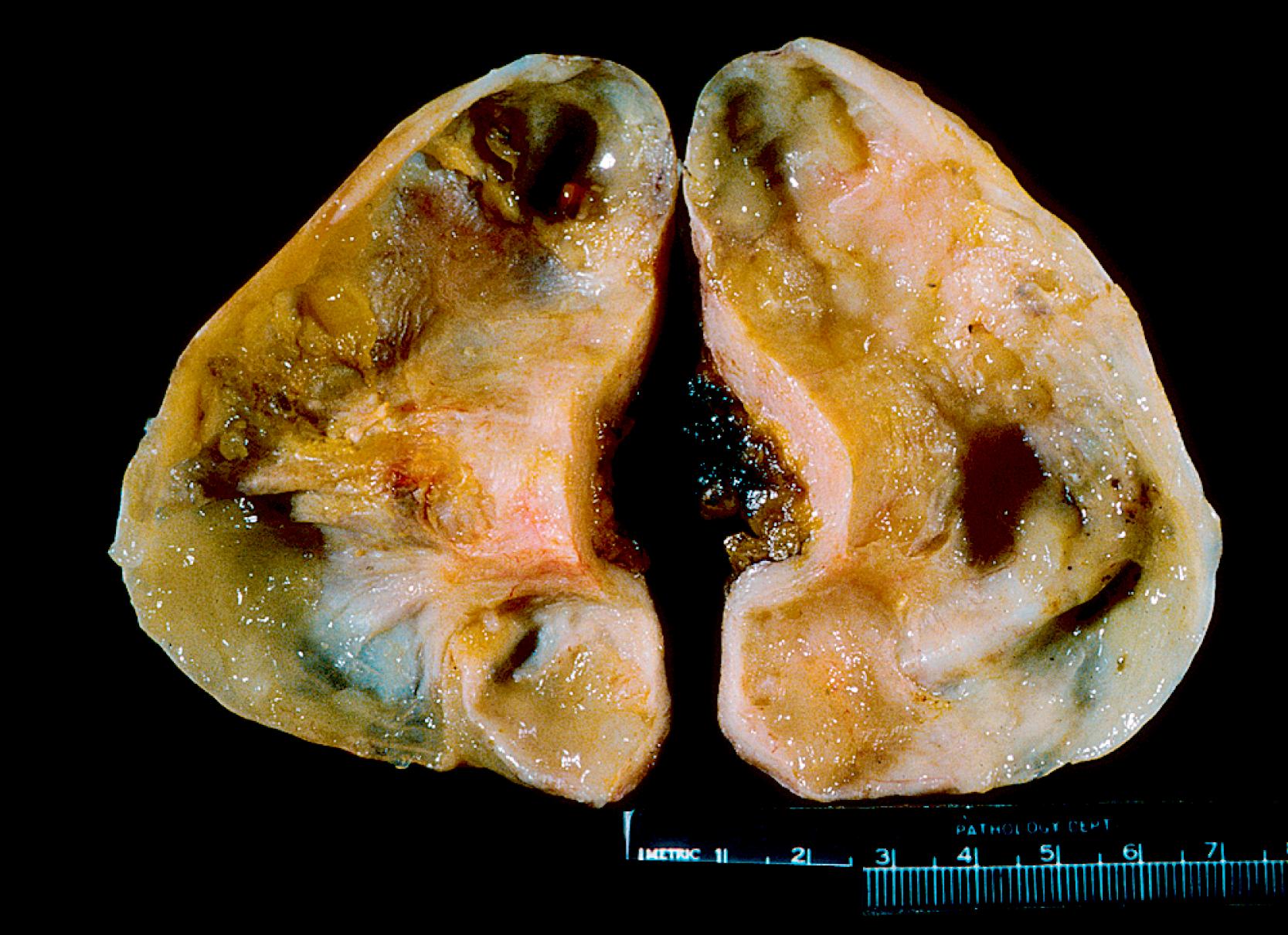
On microscopic examination, LAMNs show either villous or flat neoplastic mucinous epithelium, but either way they are often associated with atrophy of lymphoid tissue. , , In villous tumors, the villi are typically filiform in appearance and contain scant lamina propria ( Fig. 28.3 ). The epithelium contains abundant cytoplasmic mucin that may compress the cell nuclei. Cells with small compressed nuclei may appear deceptively benign or even nonneoplastic ( Fig. 28.4 ). The villi are usually straight, but occasionally they show a variable degree of luminal serration. In fact, in some circumstances, these tumors may resemble a hyperplastic polyp or a serrated neoplasm (see later). Alternatively, the epithelium may be flat, scalloped, or undulating in appearance ( Fig. 28.5 ). Denudation of the epithelium is common in these tumors, particularly in those with attenuated epithelium, and in this circumstance, distinction from a benign nonneoplastic retention cyst may be difficult (see later). In some cases, nearly the entire appendiceal mucosa may be denuded of epithelium. In these cases, extensive sampling may be needed to identify the foci of neoplastic epithelium. , LAMNs are composed of columnar cells that are rich in mucin and typically display low-grade nuclear atypia. Common features include nuclear elongation, hyperchromasia, pseudostratification, inconspicuous nucleoli, infrequent mitoses, and apoptotic nuclear debris. , , Bordering areas of neoplastic mucosa may be hyperplastic-appearing epithelium with prominent crypt serration, , but the significance of this finding is uncertain.
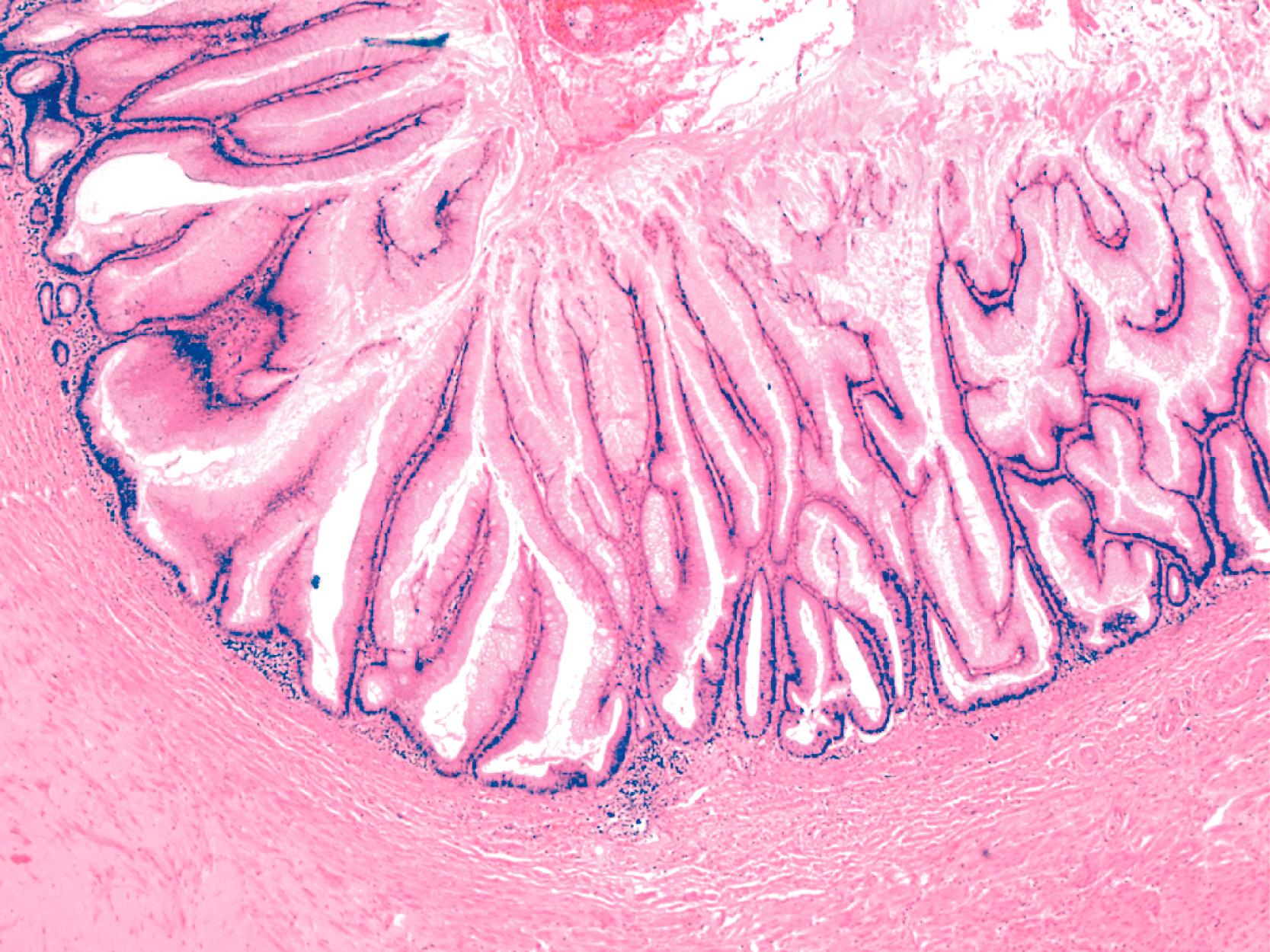
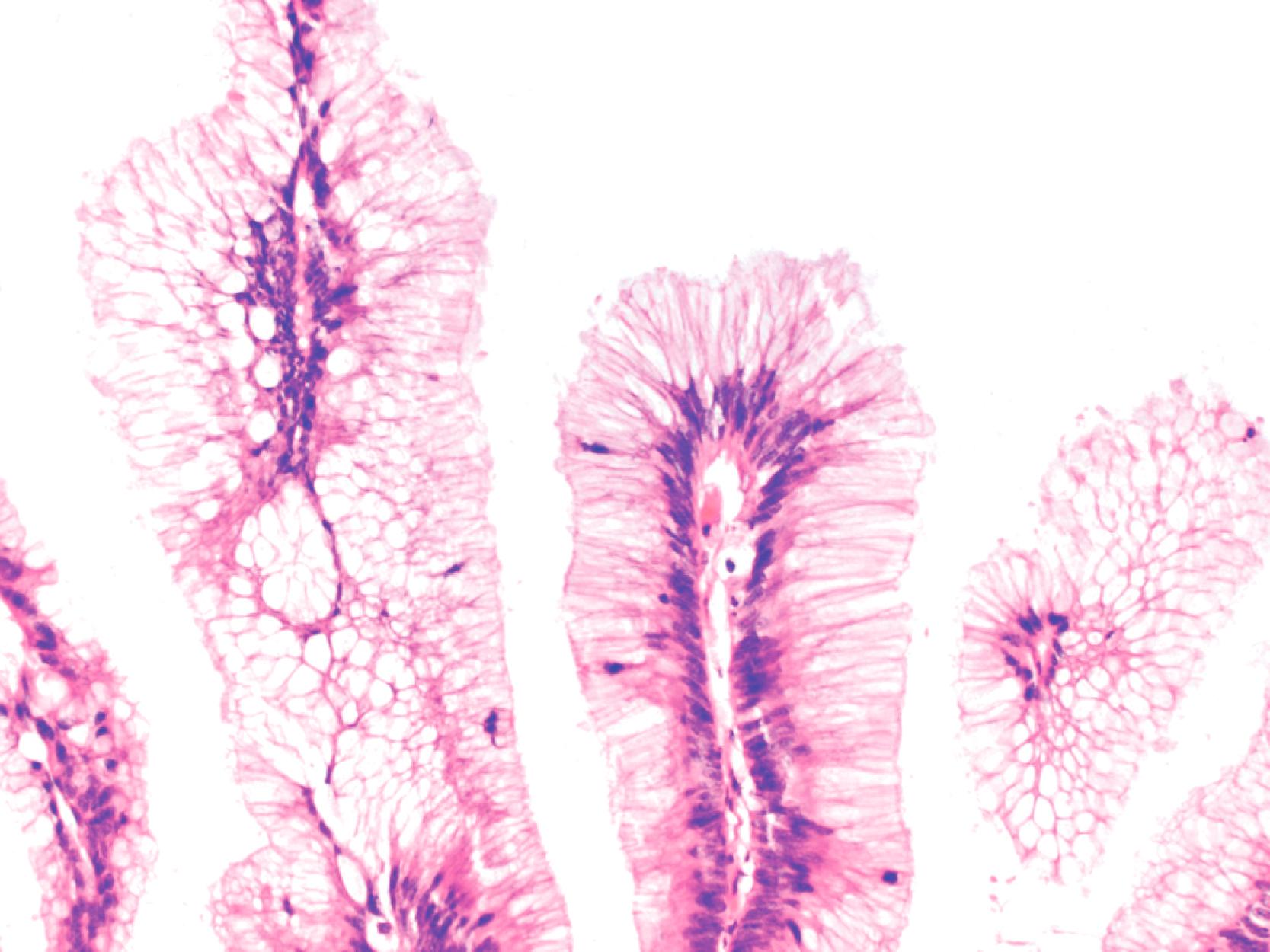
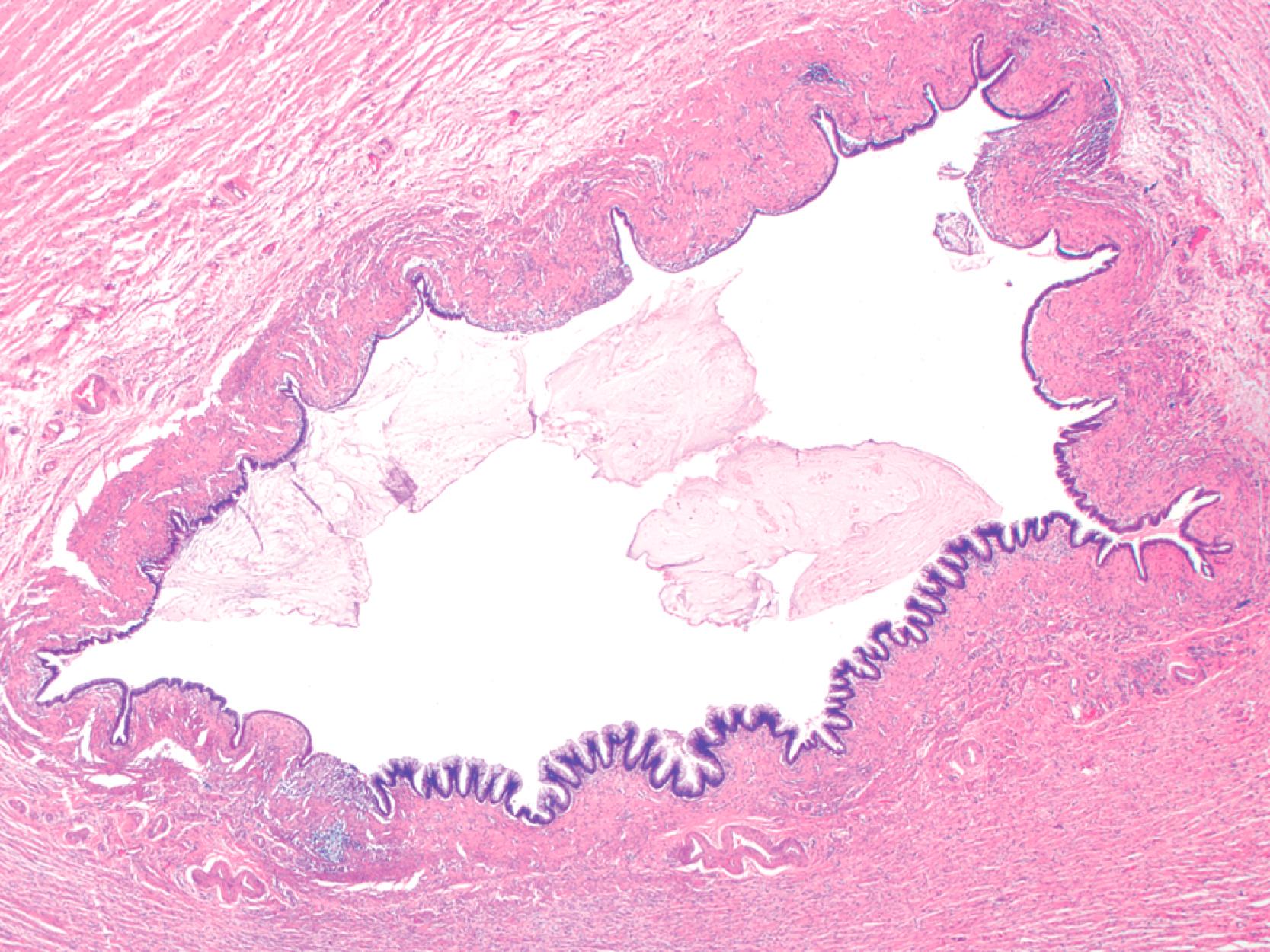
One distinctive feature of LAMNs is that they do not normally invade the appendiceal wall in a conventional manner; they do not show infiltrative and irregular glands or a desmoplastic stroma. Instead, they “invade” by showing broad areas of pushing invasion. Neoplastic epithelium, mucin, or a combination of both may appear to dissect into or through the wall of the appendix and may even cause perforation. Tumor involvement of the appendiceal wall may simulate involvement of a preexisting diverticula. However, in contrast with diverticular involvement by a LAMN, true tumor involvement of the wall of the appendix lacks lamina propria ( Fig. 28.6 ). Fibrosis of the appendiceal wall, which is common in LAMN, may result in the appearance of neoplastic epithelium in direct contact with fibrotic or hyalinized stroma, rather than situated above the muscularis mucosae with surrounding lamina propria ( Fig. 28.7 ). In fact, the appendiceal wall in LAMNs may show alterations of the muscularis mucosae and even total effacement of normal appendiceal landmarks in some cases. Fibrosis and hyalinization of the appendiceal wall may be nodular on occasion ( Fig. 28.8 ), which may represent evidence of prior episodes of mucin leakage and subsequent tissue repair. Dystrophic calcification is common, particularly in areas with prominent mucin. , Alteration of the wall of the appendix presents pathologists with challenges with regard to pathological staging. For instance, cases in which there is extension into or through the muscularis propria may be difficult to recognize when there is replacement of the muscle layers by fibrous or hyalinized tissue. However, distinction between muscularis propria and fibrotic tissue has little practical importance in patient management for patients in whom the serosa is intact (uninvolved) (see “Natural History”).
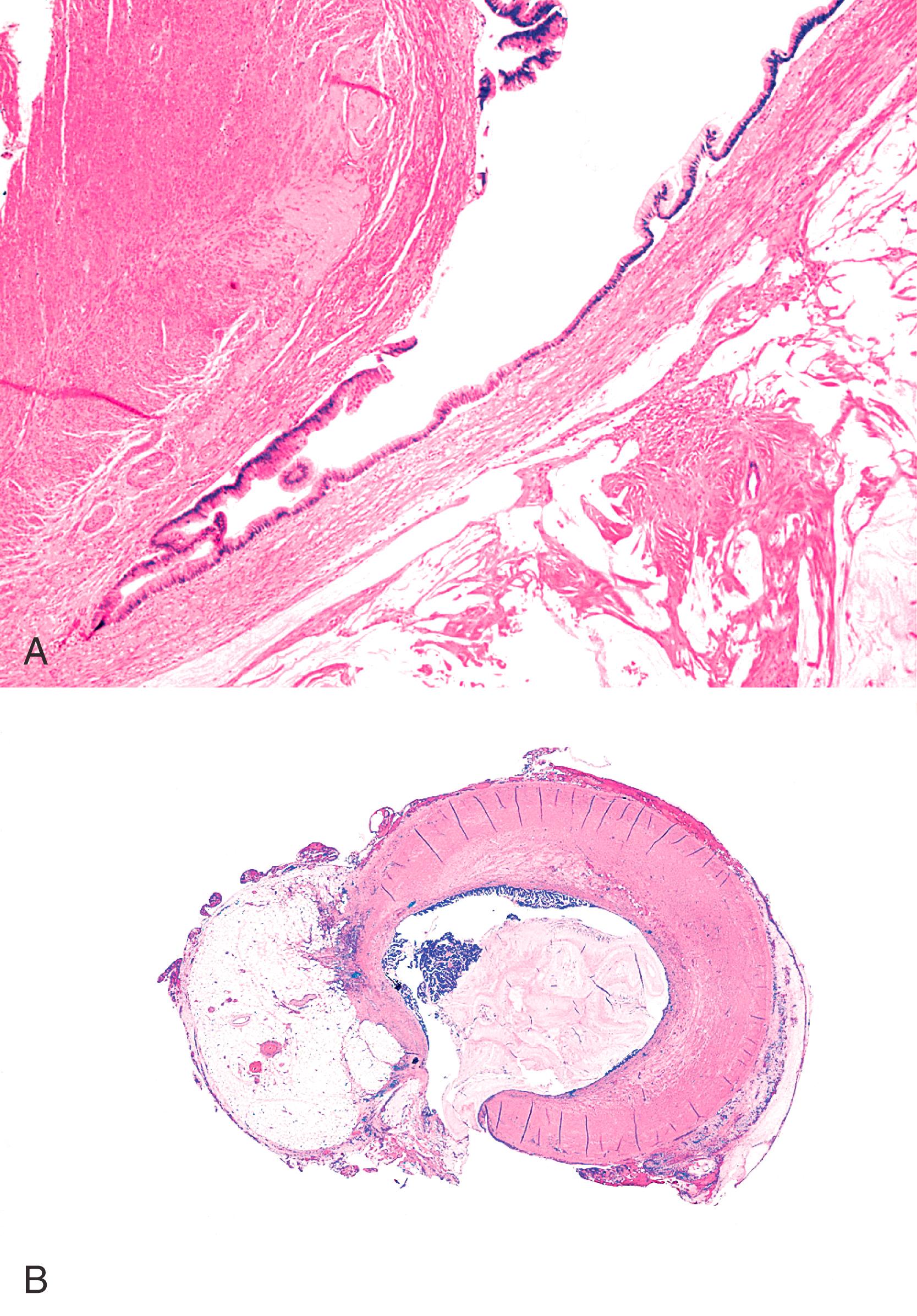
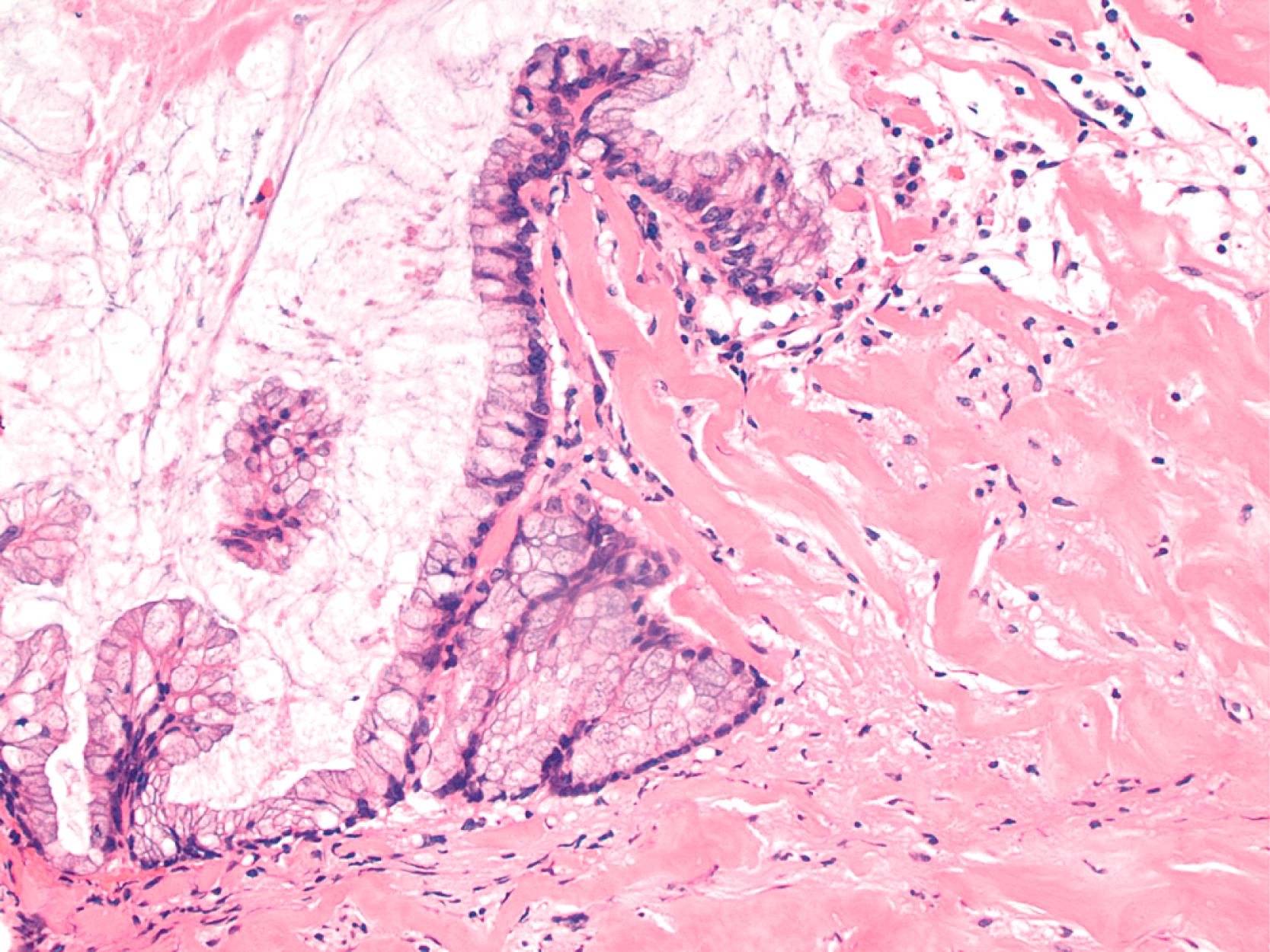
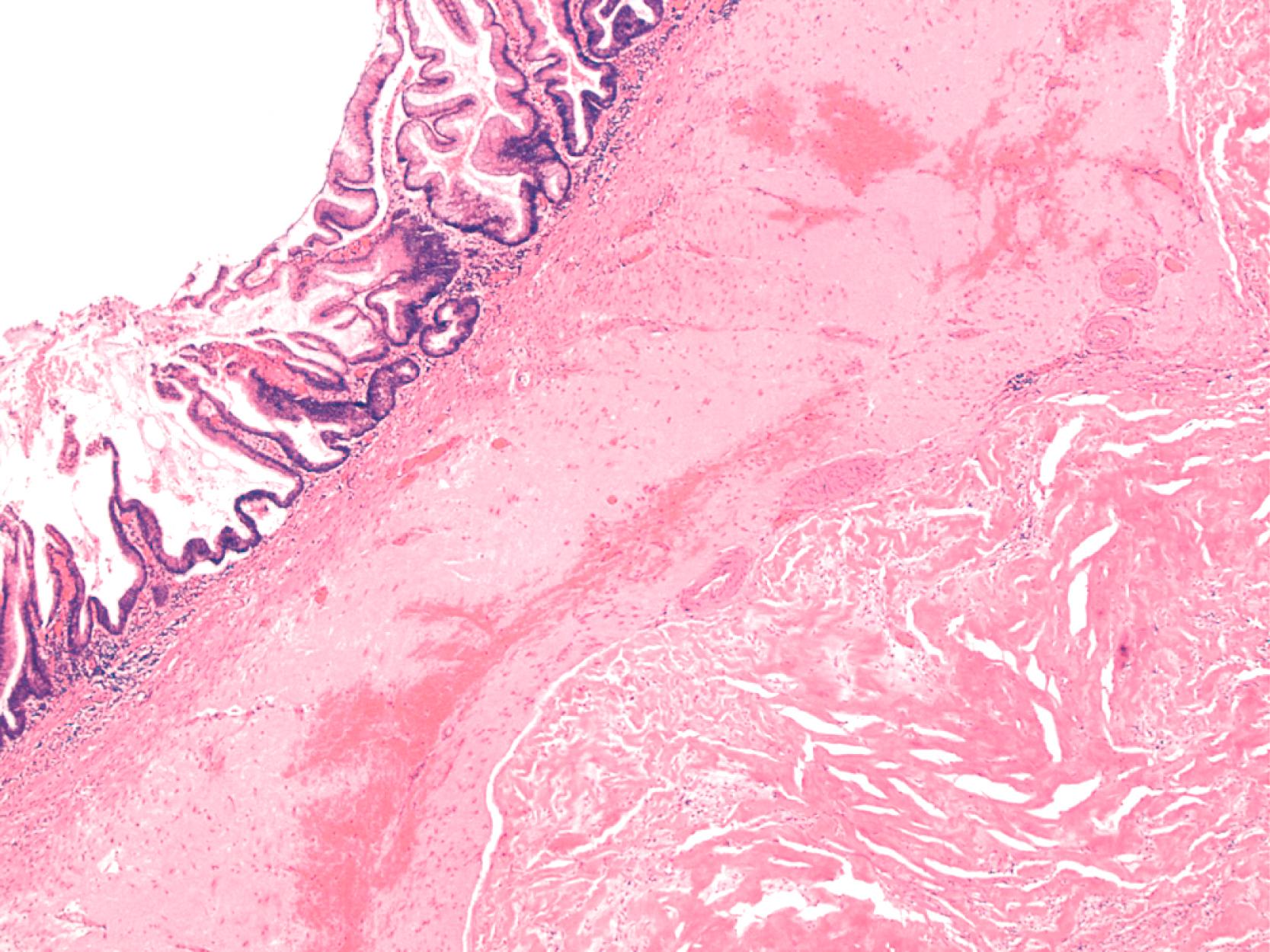
Tumors that have spread to the ovary often reveal characteristic features that allow distinction from a primary mucinous tumor of the ovary. Most often, the right ovary is the one involved. Involvement of the ovary often shows subepithelial cleft formation, with separation of the tumor epithelium from the underlying stroma ( Fig. 28.9 ). The characteristic features are elongated glands lined by tall mucinous cells, with pale mucin dissecting the ovarian stroma and regularly spaced shallow invaginations that impart a scalloped or festooned appearance to the glands. Pseudomyxoma ovarii and mucin granulomas (clusters of histiocytes with vacuolated cytoplasm) are frequently present as well. One potentially confusing feature is that the ovarian stroma surrounding infiltrating glands may be more closely packed, which creates the impression of a cambium layer that may be interpreted as evidence of a primary neoplasm. Rarely, an appendiceal tumor will spread to the ovary in the absence of peritoneal mucin or pseudomyxoma peritonei. This situation may cause consideration of a second ovarian primary tumor. One study showed that subepithelial cleft formations are, perhaps, the single best histological feature in the ovary that helps to identify a tumor as a metastatic LAMN, rather than a primary ovarian tumor, but ultimately, a combination of multiple features may be necessary to support an unequivocal origin in the appendix. In isolated cases, molecular studies, such as evaluation of KRAS and GNAS mutations, may be performed to help determine the true origin of an ovarian tumor.
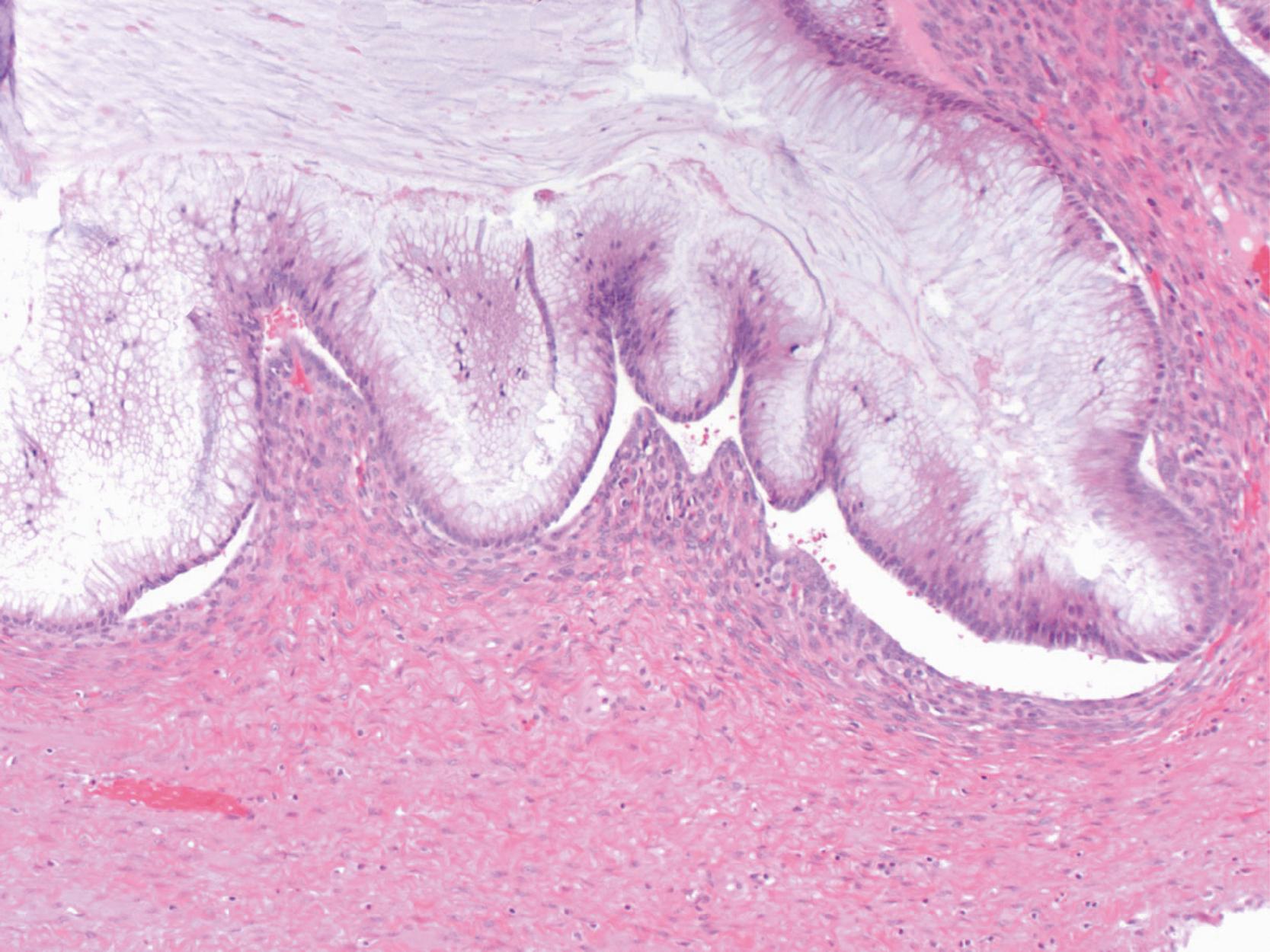
Appendiceal mucinous neoplasms and their peritoneal metastases usually express keratin 20, and about 25% to 40% coexpress keratin 7. , CDX-2 and MUC-2 are expressed in nearly 100% of appendiceal mucinous tumors and pseudomyxoma peritonei. , SATB2 is expressed in 80% to 100% of appendiceal mucinous neoplasms, and this marker may be particularly useful to distinguish an appendiceal primary tumor from an ovarian primary tumor. ,
As per the definition of this tumor discussed earlier in this chapter, appendiceal adenomas represent a tumor that morphologically resembles a colorectal adenoma, with intestinal-type dysplastic epithelium, in either a tubular adenoma or villous configuration, but without excess mucin production. Cystic tumors lined by a single layer of flat, scalloped, or undulating epithelium are, by definition, LAMNs, not adenomas. The villi typical in villous adenomas are lined by intestinal-type epithelium, with a reduced amount of lamina propria, whereas the villi in LAMNs are typically lined by hypermucinous epithelium with virtually no appreciable lamina propria (“filiform” villi). Any tumor that shows a pushing front into the submucosa or muscular wall, perforates the appendix, or is associated with mucin or neoplastic mucinous epithelial cells on the appendiceal serosa or any extraappendiceal site should not be classified as an adenoma.
Retention cysts are nonneoplastic benign lesions that develop as a result of obstruction of the appendiceal lumen, although the cause of the obstruction may not necessarily be apparent. Retention cysts are relatively uncommon. They only rarely attain a size larger than 2 cm in greatest diameter. Retention cysts may be fibrotic and chronically inflamed, and they may show extensive epithelial denudation similar to a LAMN. The mucosa may be atrophic with short or flattened crypts, or it may be composed of a single layer of attenuated cuboidal epithelium, mimicking a LAMN ( Fig. 28.10 ). , Continuity of the attenuated areas with areas of relatively preserved mucosal architecture is an important clue to the diagnosis of a retention cyst. Conversely, the presence of slender filiform villi, even if only a focal finding, is more indicative of a true neoplasm. Retention cysts may also rupture and result in the presence of mucin within the peritoneal cavity. However, unlike pseudomyxoma peritonei that develops due to a neoplasm, the mucin in the peritoneal cavity as a result of a ruptured retention cyst is usually confined to the area of rupture and does not normally accumulate further after appendectomy. Microscopic examination of the mucin from a ruptured retention cyst may demonstrate varying degrees of tissue reaction and organization (showing granulation tissue in various degrees of development) and mesothelial hyperplasia. Epithelial cells are not present within the mucin in ruptured retention cysts. Thus their presence should exclude this diagnosis unless contamination of the mucin with epithelium may have occurred as a technical complication of specimen prosection.
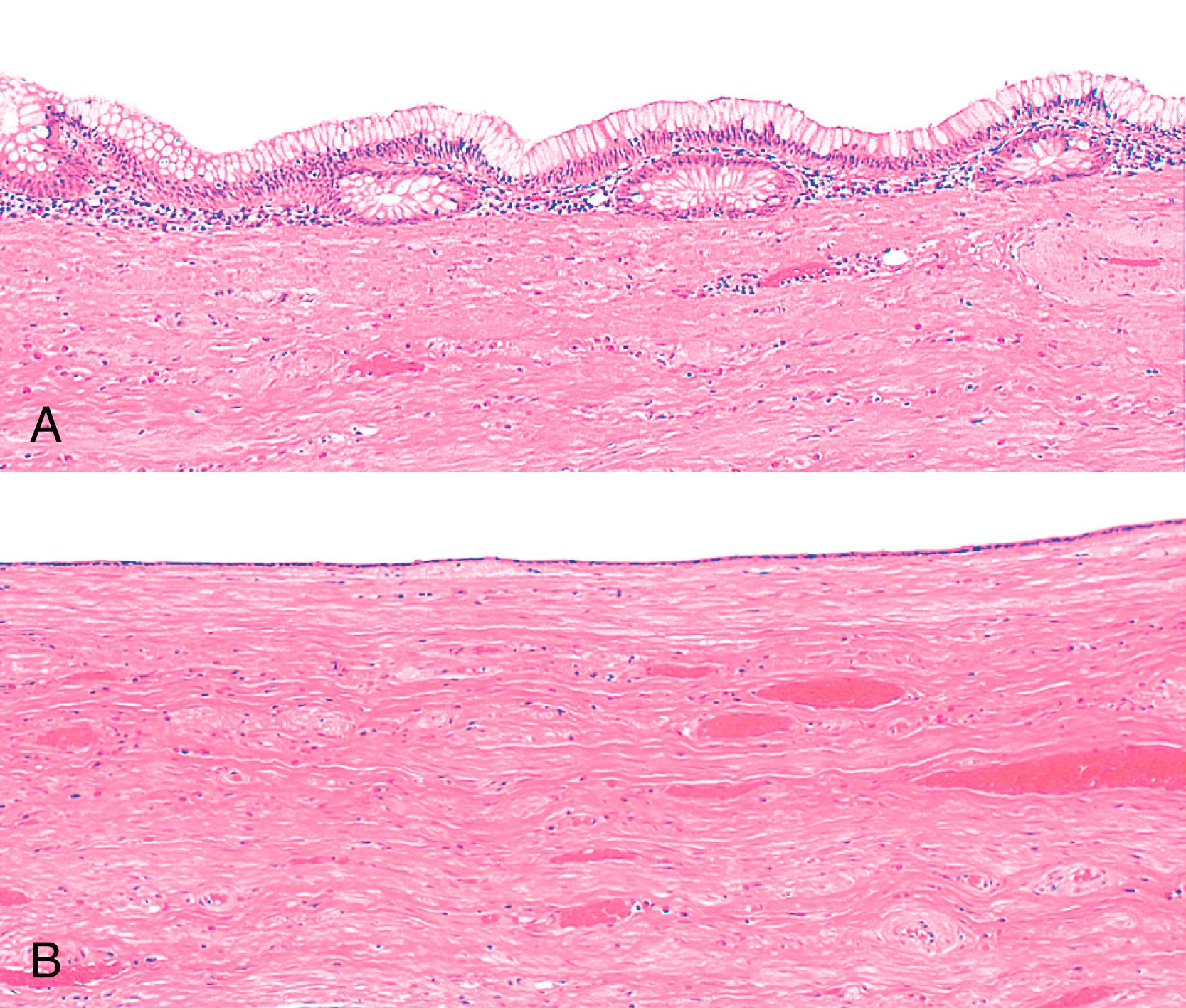
The presence of diverticula in the appendix should always alert the pathologist to search for a neoplasm that may have caused appendiceal obstruction. , However, not uncommonly, appendiceal diverticula may rupture and result in extrusion of mucin into the wall of the appendix and on the serosa, which may raise concern for a mucinous neoplasm ( Fig. 28.11 ). , In addition, the presence of hyperplastic and reactive changes of the epithelium within the diverticula may also be mistaken for a neoplastic process. Some appendices with diverticula are dilated, similar to retention cysts, and reveal an attenuated epithelial lining in continuity with otherwise relatively preserved mucosa. The presence of an everted diverticulum or the presence of fragments of diverticular epithelium at the rupture site on the serosa may also be confused with localized pseudomyxoma peritonei. There are some features that pathologists can use to differentiate a ruptured diverticulum from a true mucinous neoplasm ( Box 28.2 ). For instance, in some cases of appendiceal diverticula, the appendix may contain several diverticula, which helps alert the pathologist to the correct diagnosis. Hyperplastic epithelium often shows crypt serration, crypt disarray, and hyperplastic changes with abundant mucin-producing cells, which is typically more pronounced in the upper half of the mucosa. Further, nonneoplastic crypts are normally separated by lamina propria, and they show little or no crowding. In contrast, typical LAMNs show back-to-back crypts with scant lamina propria as well as elongated slender villi that protrude into the lumen of the appendix. One other helpful feature is that appendices with diverticula often show Schwann cell transformation of the lamina propria ( Fig. 28.12 ). , This may be caused by the effects of obstruction.

Appendiceal mucinous neoplasm
Low-grade appendiceal mucinous neoplasm (LAMN)
High-grade appendiceal mucinous neoplasm (HAMN)
Serrated lesion and polyp
Hyperplastic polyp
Serrated lesion without dysplasia
Serrated lesion with dysplasia
Adenocarcinoma
Adenocarcinoma NOS
Mucinous adenocarcinoma
Signet ring cell carcinoma
Undifferentiated carcinoma, NOS
Neuroendocrine neoplasm
Neuroendocrine tumour (NET)
Neuroendocrine carcinoma (NEC)
Mixed neuroendocrine/nonneuroendocrine neoplasm (MiNEN)
Goblet cell adenocarcinoma
Multiple diverticula, many of which are intact, may be present
Dilatation of the appendiceal lumen, lined by a flat single layer of cuboidalized epithelium segueing into atrophic mucosa with retained crypt architecture
Mucosal hyperplastic changes with disarrayed but preserved crypts separated by lamina propria
Absence of slender filiform villi or tightly scalloped mucosal architecture
Mucosal Schwann cell proliferation
Chronic inflammation and fibrosis
A history consistent with interval appendectomy

Endometriosis of the appendix can cause obstruction with the secondary formation of a retention mucocele, diverticulum, or perforation. In the appendix or cecum, endometriosis may also show intestinal metaplasia of the epithelium, which can mimic LAMN or a mucinous adenocarcinoma. Deposits of endometriosis may reveal the presence of glands lined by mucinous cells, which are occasionally in continuity with endometrial-type glands, and surrounded by a cuff of endometrial-type stroma ( Fig. 28.13 ). , Stromal decidualization may be present, particularly in pregnant patients. Occasionally, some of the intestinal glands may be cystically dilated with mucin and endometrial stroma. This makes it difficult to distinguish endometriosis from dissecting glands of a LAMN; immunohistochemical stains for estrogen receptor, progesterone receptor, and CD10 may help demonstrate endometrial stroma. Rarely, dysplasia has been reported within endometriotic intestinal glands, , although reactive changes often mimic dysplasia in this setting, so this feature should be evaluated carefully.

The prognosis of LAMN is highly dependent on stage of the tumor, or, more precisely, the presence or absence of neoplastic epithelium located outside of the appendix, and/or within the peritoneal cavity. , , The eighth edition of the AJCC includes a new staging system for LAMNs ( Table 28.1 ) in which Tis(LAMN) was specifically created for tumors in which the epithelium, or acellular mucin, pushes into but not through the muscularis propria, and, as a result, there is no T1 or T2 stages in this new system. Cases in which either mucinous epithelium or acellular mucin extends into the subserosa, or mesoappendix, are staged as T3. Tumors that perforate the serosa with either acellular or cellular mucin are classified as T4a. However, it is important to note that the prognosis of LAMN does not necessarily align well with the T stages. Thus a complete and accurate description of the location and extent of mucin and the mucinous epithelial cells should always be described in pathology reports of patients with these tumors.
| T Stage | LAMN | HAMN |
|---|---|---|
| Primary tumor cannot be assessed | Tx | Tx |
| No evidence of primary tumor | T0 | T0 |
| Carcinoma in situ (invasion of the lamina propria or invasion into but not through the muscularis mucosae) | Tis(LAMN) | Tis |
| Tumor or acellular mucin extends into the submucosa | T1 | |
| Tumor or acellular mucin extends into the muscularis propria | T2 | |
| Tumor or acellular mucin extends into the subserosa or mesoappendix | T3 | T3 |
| Tumor or acellular mucin involves the appendiceal serosa | T4a | T4a |
LAMNs that are confined to the appendix, without extraappendiceal mucin, are almost always cured by an appendectomy. , This includes tumors that meet the definition of Tis(LAMN) or T3. Although tumors that perforate the serosa, either with or without mucinous epithelial cells on the serosa, are staged as T4a, there is a marked difference in prognosis depending on whether the serosa is involved by acellular mucin only or by epithelial cells. LAMNs associated with acellular mucin on the appendiceal serosa carry a low risk of recurrence or progression to pseudomyxoma peritonei, whereas those with epithelial cells on the serosa or within the peritoneal cavity carry a high risk of recurrence. In one multiinstitutional study, the authors collected 65 patients with ruptured appendiceal mucinous tumors, all of whom had at least 6 months of follow-up. Fifty of these patients had acellular mucin located within the right lower quadrant, and only 2 (4%) of them had local recurrence after 56 and 92 months of follow-up. In contrast, 15 tumors were associated with clusters of low-grade neoplastic epithelium within the extraappendiceal mucin. Five of these cases (33%) recurred in the form of diffuse pseudomyxoma peritonei within 24 to 87 months, and one patient died of disease at 60 months. Pai et al. studied 116 patients with mucinous tumors and came to similar conclusions. They described follow-up for 14 patients with acellular mucin limited to the right lower quadrant. One patient (7%) had a recurrence on follow-up. Three of four patients (75%) with extraappendiceal mucin containing neoplastic epithelium limited to the right lower quadrant also had a recurrence. One recent study reported that five patients with acellular mucin on the serosa did not experience recurrence after a mean follow-up of 45 months.
Acellular mucin located within the peritoneal cavity (beyond the appendiceal serosa) has been shown to confer a low risk of recurrence as pseudomyxoma peritonei. In one recent study, the authors found that patients with acellular mucin located beyond the right lower quadrant had a longer progression-free survival and overall survival compared with patients with cellular mucin deposits. In patients with remote mucinous deposits, the absence of visible disease on CT scan correlated with the presence of acellular mucin. However, one caveat is that sampling error may affect this finding because 5 of 29 patients in this study who were initially classified as having only acellular mucin within the peritoneal cavity were subsequently upstaged to cellular mucinous deposits after complete resection and evaluation of their peritoneal tumor. One series of LAMNs at various stages included eight patients with acellular mucin within the peritoneum, none of whom had a recurrence. In other reports, patients with only acellular mucin after cytoreductive surgery showed a more favorable prognosis than patients with cellular mucin deposits. ,
From these various studies, , it is evident that patients with acellular mucin within the peritoneal cavity have a much more favorable prognosis than patients with cellular peritoneal mucinous tumor deposits, regardless of whether or not the mucin is confined to the right lower quadrant. Thus evaluation for extraappendiceal mucin and neoplastic epithelium should always be performed diligently. Because the presence of acellular mucin on the surface of the appendix may have prognostic significance, it is also important to distinguish mucin carryover as a result of poor specimen handling from true mucin on the serosa. True mucin on the serosa is usually associated with mesothelial hyperplasia and/or neovascularization. Another important issue is determination of the extent of sampling that is necessary in patients with large-volume mucinous ascites to confirm the absence of epithelium. One study demonstrated that of 12 cases that initially revealed acellular mucin within the peritoneal cavity that had been well sampled, an additional 30 blocks of peritoneal mucin found epithelial cells in 2 of the cases. Ultimately, in cases with abundant mucin within the peritoneal cavity, pathologists should sample the mucin thoroughly, beginning with a reasonable number of blocks; if no mucinous epithelium is identified in these initial sections, additional sampling of perhaps another 20 or 30 blocks may be prudent.
In contrast, LAMNs with diffuse (nonlocalized) peritoneal seeding of neoplastic epithelium and mucin typically have a progressive clinical course that frequently results in death of the patient unless managed aggressively (see ”Pseudomyxoma Peritonei”).
Simple appendectomy is considered sufficient treatment for LAMNs that are confined to the appendix. In some cases, the margin of resection reveals the presence of intraluminal mucin, or it may show residual dysplasia. Although some authorities advise additional surgery for patients with a positive margin (defined as either mural dissecting mucin or luminal neoplastic epithelium in a section of the appendiceal margin), , there are some data to suggest that cases with a positive margin, as defined earlier, are unlikely to show residual neoplasia in a subsequent colectomy specimen or to be associated with an adverse outcome. , , However, rare examples of residual tumor, presumably within the remnant of the appendix, have been reported. Thus we feel that the precise status of the appendectomy margin should be reported (describing dissecting mucin, neoplastic epithelium, or other) to help the treating physician make a decision regarding cecectomy versus radiological surveillance in the management of a patient with a “positive” margin.
Given the possibility of peritoneal recurrence in patients with a ruptured LAMN, those with acellular mucin on the periappendiceal serosa should be followed closely to ensure that either localized or diffuse pseudomyxoma peritonei does not develop. Radiographic imaging of the abdomen and pelvis is usually considered the preferred method of surveillance. Tumors that spread to the right lower quadrant reveal a higher risk of recurrence, but appropriate management for these patients remains controversial. For instance, radiological surveillance may be appropriate for some patients. , Right hemicolectomy offers no additional benefit over appendectomy alone for patients with LAMN, even in patients that contain extraappendiceal mucin and neoplastic epithelium. , Tumors that have disseminated into the peritoneal cavity are treated either by multiple peritonectomies and heated intraperitoneal chemotherapy (see “Pseudomyxoma Peritonei”) or, if the patient is not a candidate for these aggressive approaches, by tumor debulking.
HAMN is a recently introduced term , proposed for tumors that show architectural features of a LAMN (e.g., pushing-type invasion), but with high-grade cytological features.
Patients with HAMN present clinically similar to those with LAMN, with abdominal pain and symptoms referable to a mass lesion. However, bulky peritoneal disease may be more frequent in patients with HAMN compared with those with LAMN. ,
Similar to LAMNs, HAMNs show frequent KRAS mutations, and about 50% also show GNAS mutations. , In addition, HAMNs may show mutations in TP53, ATM, RNF43, or APC . , , They may show p53 overexpression by immunohistochemistry as well.
The gross features of HAMN are identical to those for LAMN. Histologically, HAMNs reveal similar architecture to LAMNs (flat, scalloped, undulating, or villous growth of epithelial cells). However, at least focally, and in some cases diffusely, the degree of epithelial atypia is high-grade. High-grade features include marked nuclear enlargement, anisonucleosis, hyperchromasia, prominent nucleoli, and numerous mitoses. In high-grade areas, the epithelium may also show areas of complexity, such as the presence of full-thickness nuclear stratification and the formation of micropapillary or cribriform architecture ( Fig. 28.14 ). The neoplastic cells may also show less mucinous differentiation and appear more columnar, similar to colonic adenomas.

HAMNs may be confined to the mucosa or show pushing invasion, with stromal changes such as fibrosis of the lamina propria, loss of the lymphoid tissue compartment, or fibrosis, elastosis, or calcification of the wall of the appendix. These tumors may rupture, and there can be mucin extrusion either with or without neoplastic mucinous epithelial cells within the extraappendiceal mucin. In contrast with LAMNs, HAMNs are staged according to the T stages used for invasive adenocarcinomas ( Table 28.2 ). Thus a HAMN that pushes into the muscularis propria is classified as T2, not Tis(HAMN). The difference in grading between LAMN and HAMN was initially proposed because of the concern that HAMNs have a higher risk of recurrence (as pseudomyxoma peritonei) compared with LAMNs. However, there is currently no data to substantiate more aggressive staging of HAMNs. For instance, HAMNs that have not perforated the serosa show a low risk of dissemination, similar to LAMNs.
| Extent of Mucinous Tumor | Stage | Comment |
|---|---|---|
| Acellular mucin on peritoneal surfaces other than the appendiceal serosa | pM1a | Requires adequate sampling to exclude mucinous epithelium |
| Cellular peritoneal mucinous tumor deposits on peritoneal surfaces other than the appendiceal serosa | pM1b | Peritoneal mucinous tumor that pushes into the underlying organ or ovarian involvement are pM1b |
| Mucinous tumor deposits to sites other than the peritoneal cavity | pM1c | Examples include pleural mucinous tumor deposits or pulmonary metastases |
By definition, LAMNs have low-grade cytological atypia. A diagnosis of HAMN should be reserved for tumors that show high-grade cytological atypia, even if focal.
Become a Clinical Tree membership for Full access and enjoy Unlimited articles
If you are a member. Log in here